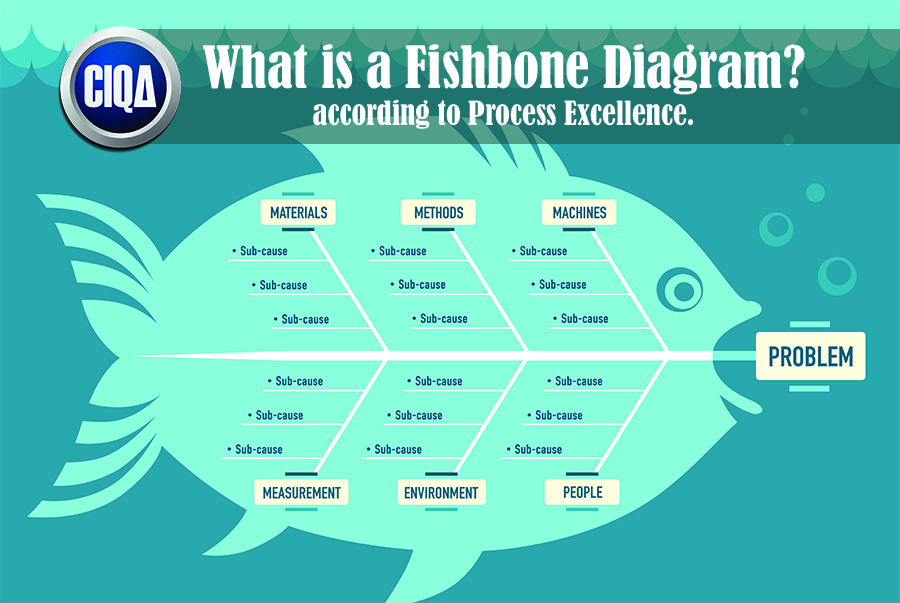
Understanding What is a Fishbone Diagram as a Tool for Troubleshooting.

|
In this article, you will learn what is fishbone diagram and how to use it in process excellence, lean six sigma, and lean manufacturing activities. FISHBONE DIAGRAM DEFINITIONA Fishbone Diagram (also called a Cause and Effect Diagram or Ishikawa Diagram) is a visualization tool for categorizing the potential causes of a problem in order to identify its root causes. sigma definitions This lean six sigma tool is considered one of the seven basic quality tools in process excellence. The fishbone diagram describes the most probable causes for an effect or problem. It is important to do not confuse the problem with the cause of the problem. In medicine, for example, fever and pain are the effects and symptoms of a problem. Meanwhile, viral infection and trauma may be the root causes. DEFINE WHAT IS THE PROBLEM?A problem is defined as the effect, symptom, observed behavior, failure or error that is triggered and caused by one or more root causes. The advantages of the fishbone diagram are that can be used to structure a brainstorming session. Because you can sort ideas into useful categories. It is recommended to use this tool for just one problem at a time. NOTE: Highly experienced people can combine more than one problem in the same Fishbone diagram. WHEN IS RECOMMENDED TO USE A FISHBONE DIAGRAMSuitable when a team of persons shall be involved in brainstorming to evaluate one complex problem. When required the identification of all possible or potential causes for a problem. When a team’s thinking tends to fall into ruts. INSTRUCTIONS TO PREPARE A FISHBONE DIAGRAM (CAUSE AND EFFECT DIAGRAM)
FISHBONE DIAGRAM EXAMPLEThe following fishbone diagram was prepared to understand a particular problem of bioburden contamination in medical device products found out of specifications. During the brainstorming were used the six generic headings to present the probable root causes and ideas. As you can see the layers of branches show thorough thinking about the causes of the problem. 
For example, under the heading “Machines,” the idea “maintenance” and “validation” can show several kinds of equipment and then several specific machine models. CIQA is a quality and regulatory consultant with 25 years of experience developing products and managing projects in the medical device supply chain, and pharmaceutical industries. Rest assured of the safety or being in the right hands. Our Lean Manufacturing team could provide you a broad range of professional expertise implementing these techniques and tools. SUBSCRIBE AND FOLLOW US TO LEARN MORE.For more details about What is a Fishbone Diagram, follow us.Three (3) Options to Create Document Control Management DCM Procedures:Bronze Option. You Can Create Your Own Quality Procedures, using a Template.You can download samples of the Document Control Management DCM procedure templates in .pdf format. To see the complete list of the most popular quality procedures templates, click here. In addition, you can request a quotation to buy online a full SOP template document in MS Word format that is completely editable, ready to fill, and adapt to your specific needs. Silver Option. We Can Bring You Formal Training about What is a Fishbone Diagram.This option is recommended if you want to learn more about how to build robust quality system procedures. One of our expert(s) can provide online step-by-step training to your team (unlimited assistance) on how to build reliable SOPs using our template(s). Also, you can improve your corporate quality procedures and policies by incorporating our template(s) and tools. It includes a fully editable template from the Bronze option, plus training, exams, and a training certificate for each assistant. Request a quote now. Gold Option. We Can Create Customized Quality Procedures.One of our expert(s) will create and prepare your customized SOPs with the inputs and specific information of your company. It includes a fully editable template from the Bronze option, plus online support in document creation, implementation, and training. Request a quote online. Get in compliance today, CONTACT US (Hablamos Español)REFERENCES: What is a Fishbone Diagram.httpss://en.wikipedia.org/wiki/Lean_Six_Sigma httpss://www.greycampus.com/blog/quality-management/a-brief-introduction-to-lean-and-six-sigma-and-lean-six-sigma |

Ramon Cayuela, MS, BS, Chemical Engineering
CIQA President and CEO.
I've been working in validation engineering since 1992 with many multinational pharmaceutical companies. I love sharing my passion and knowledge with others. If you have any questions about anything (or just have general questions). I will be more than happy to assist you. You can count on the BEST customer service on CIQA. I go to great lengths to make sure my clients are 100% satisfied with their purchases and check emails/messages consistently throughout the day. You can rest assured that everything being sold here is as-described or your money back. I look forward to working with you!
Related Articles
Subscribe to get validation
news and free tips by email.
Need Additional Help?















